WPA Aids the Farmer - Farm to Market Roads - c1937
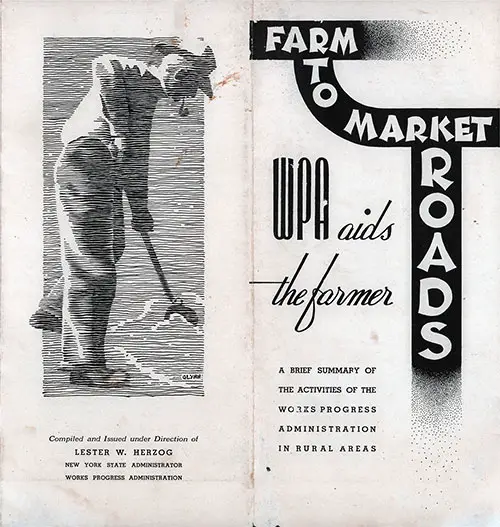
Covers, WPA Aids the Farmer: Farm to Market Roads, Compiled and Issued under Direction of Lester W. Herzog, New York State Administor, Works Progress Administration circa 1937. GGA Image ID # 151605288e
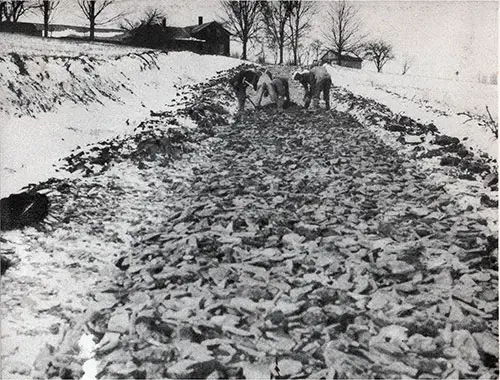
WPA Workmen Laying Stone Base for Town of Cuyler Road Which Will Have a Gravel Top and Adequate Shoulders. WPA Aids the Farmer: Farm to Market Roads, Compiled and Issued under Direction of Lester W. Herzog, New York State Administor, Works Progress Administration circa 1937. GGA Image ID # 151607ceda
More than two million of the approximately thirteen million people of the Empire State live on farms and in rural communities north of the Bronx. Their welfare is inextricably interwoven into the well-being of the City dwellers. Both mast prosper to make prosperity general.
The cycle of hardship ushered in with the 30's made this interdependence dearly evident. Commerce and industry went stagnant and farm incomes dropped almost to the vanishing point.
The Works Progress Administration was born of this condition. It evolved a program of aid to both city and country and adjusted its activities to the needs of the communities in which its projects were prosecuted.
An outstanding feature of the WPA program of aid to farm communities has been road improvement, resulting in transition from the old condition of almost impassable highways to the present growing network of farm-to-market thoroughfares.
But there are also many other lines of farm and village betterment work, such as flood control, sewage disposal, water supply and sewing rooms as well as in educational opportunities, recreation facilities and other non-construction activities.
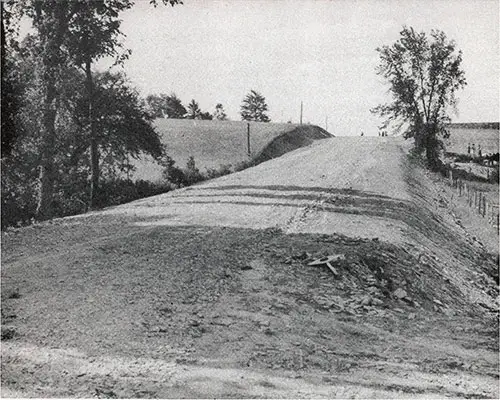
Mcdonough-Germantown Road, Where Fill Is Being Placed and Grade Reduced. WPA Aids the Farmer: Farm to Market Roads, Compiled and Issued under Direction of Lester W. Herzog, New York State Administor, Works Progress Administration circa 1937. GGA Image ID # 1517188e01
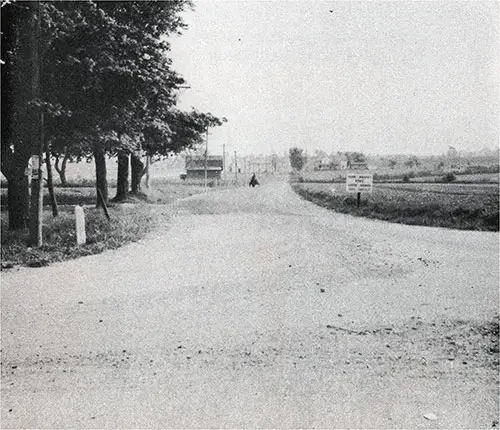
Typical of Farm-To-Market Roads Constructed by WPA and Already in Use Is This Gravel-Top Road Near Fredonia. WPA Aids the Farmer: Farm to Market Roads, Compiled and Issued under Direction of Lester W. Herzog, New York State Administor, Works Progress Administration circa 1937. GGA Image ID # 15175596b3
One of the major problems confronting New York State farmers for many years has been the time element in marketing foodstuffs and crops. The major share of rural Income in upstate New York is derived from milk and its byproducts, eggs, fruit and truck crops, all of which must be speedily transported from farm to market to bring top prices.
WPA's part in meeting the problem has been to build, repair and resurface farm-to-market roads. Under the sponsorship of rural communities or, in many cases, through the County Board of Supervisors, hundreds of miles of dirt roads loading from farms and isolated villages have been improved, bringing the farmers into swifter and easier communication with the main highways leading to their best markets.
Since its Inception in 1935, upstate New York WPA has built 1,368 miles of bituminous and concrete primary roads in rural territory, as well as 494 miles of brick or block secondary highways and reconstructed 239 miles of dirt, stone or gravel unpaved thoroughfares.
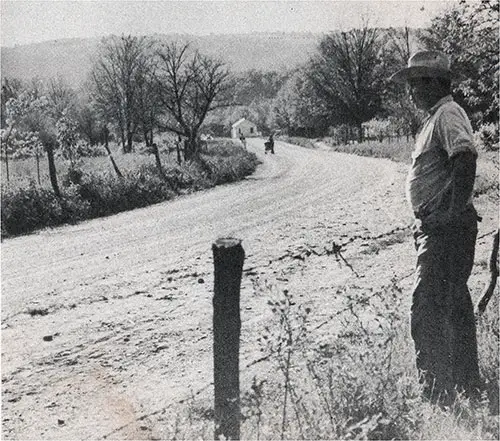
Extending Two Miles From the State Highway at Lafayette Through Onondaga Indian Reservation to Route 11-A Is This New, WPA-Built Hemlock Road. WPA Aids the Farmer: Farm to Market Roads, Compiled and Issued under Direction of Lester W. Herzog, New York State Administor, Works Progress Administration circa 1937. GGA Image ID # 1517f25a52
Aside from the financial benefits accruing to farmers from a vastly improved farm-to-market road system, many of the rural highways were dangerous from the viewpoint of vehicular safety.
Cars forced off the shoulder-less roads frequently brought death or injury to autoists. In correction of this condition 1,833 miles of shoulders and drainage ditches have been built or graded, smoothened and straightened up to this time and the work is still going on.
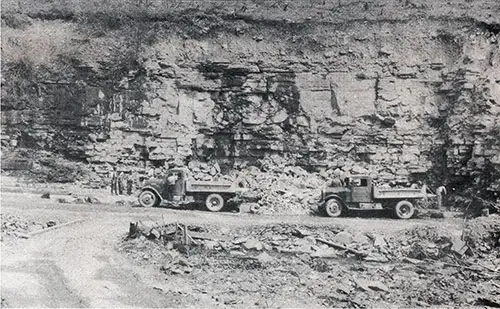
Solon Quarry, Employing Thirty Relief Workmen, Supplies Rock for County Roads. WPA Aids the Farmer: Farm to Market Roads, Compiled and Issued under Direction of Lester W. Herzog, New York State Administor, Works Progress Administration circa 1937. GGA Image ID # 1518569597
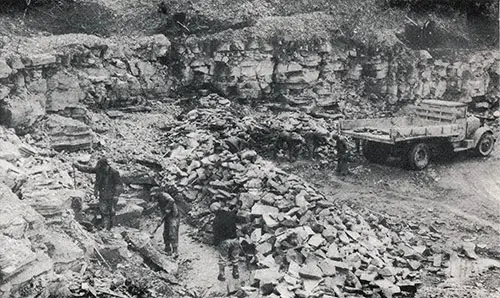
Smithville Quarry, Showing Men Excavating Stone to Be Used for Road Base in Chenango County. WPA Aids the Farmer: Farm to Market Roads, Compiled and Issued under Direction of Lester W. Herzog, New York State Administor, Works Progress Administration circa 1937. GGA Image ID # 15185cde8a
In Cortland and Chenango Counties local supervisors have sponsored well-planned road improvement programs. Both counties have quarry projects to provide winter work for the unemployed men.
These quarries furnish crushed stone for permanent, hard surfaced roads. Chenango has three, large farm-to-market projects in operation, while Cortland County has an authorized program for the improvement of twenty-two miles of road.
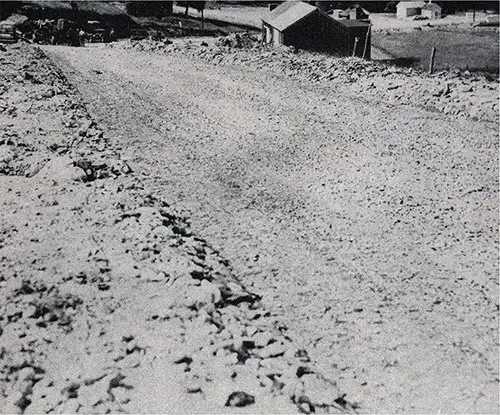
Smyrna Road, Plymouth, Chenango County, in Process of Construction. WPA Aids the Farmer: Farm to Market Roads, Compiled and Issued under Direction of Lester W. Herzog, New York State Administor, Works Progress Administration circa 1937. GGA Image ID # 15183985df
Space is inadequate to enumerate the hundreds of road projects operated in rural communities. But a few can be cited as representative examples of what WPA is doing to bring farms and markets into closer relationship more advantageous to both.
Long a source of inconvenience to muck farmers in the Oswego County area, old Whittaker Road on the outskirts of the City of Fulton has been replaced by a modern twenty-eight-foot highway, three lanes wide.
This WPA project includes nearly 5,000 feet of half round curbing, which provides a neat outline for the three-car pavement and gives motorists a clear perspective.
Illustrative of the farm-to-market WPA road jobs is the construction work under way in the Town of Carrollton, Cattaraugus County. A stone base penetration road, with necessary drainage and landscaping, provides a shorter route from the Buffalo-Pittsburgh highway through Allegany State Park to Jamestown and enables the farmers to get their produce to those cities in a fraction of the time it formerly took.
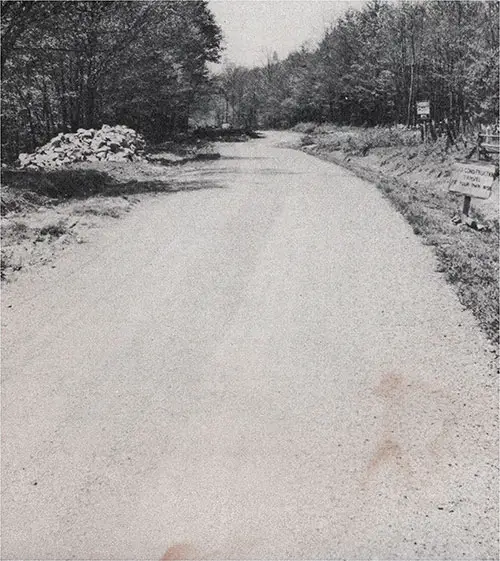
Limestone Run Road, Town of Carrollton, Another WPA Gravel-Top Road Through Rural Territory. WPA Aids the Farmer: Farm to Market Roads, Compiled and Issued under Direction of Lester W. Herzog, New York State Administor, Works Progress Administration circa 1937. GGA Image ID # 151899f7bf
Onondaga County, home of the State Fair, has more than 100 miles of new farm-to-market roads, including a network in the Onondaga Indian reservation, sponsored by the State of New York.
At the State Fairgrounds, mecca of all Empire State farmers, buildings have been repaired and painted, shrubs and trees planted, flower gardens laid out and the race track conditioned as part of a WPA project sponsored by the Slate Department of Agriculture and markets.
Franklin and Clinton Counties, dairy farming centers, have been the scene of extensive rural road reconstruction. Townships in both of these northern border counties have sponsored many such projects and the Clinton County Highway Department has initiated county-wide work of this nature.
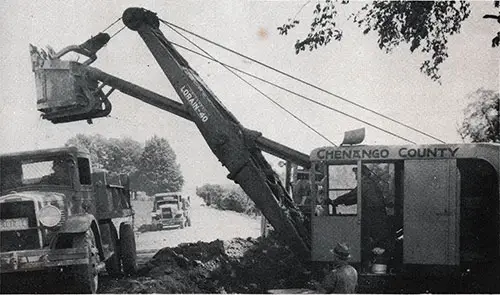
Shovel Working on Wilcox Road project, Sherburne, Chenango County. WPA Aids the Farmer: Farm to Market Roads, Compiled and Issued under Direction of Lester W. Herzog, New York State Administor, Works Progress Administration circa 1937. GGA Image ID # 1518517428
Comparable in scope to the farm-to-market program is the community rehabilitation program which has given to more than 200 upstate rural areas, for the first time, sanitary sewer systems.
Mention of the scope of WPA's program In rural upstate New York would not be complete without including the scores of school buildings in farming communities that have been renovated and reconditioned or in many cases entirely built.
Under the Adult Education and Recreation program of WPA, activities are carried on in 1,087 classes throughout the rural sections of the State. These activities give employment to about 1,200 teachers and their benefits are extended to a student body of about 65,000 plus many thousands of children who take advantage of the health-building recreation opportunities provided for them under the Federal Work Program.
The educational program ranges from the three R's to Junior and Senior High School work and also has many cultural and vocational angles.
Another phase of the work program is the sewing project. About 175 of these sewing rooms are scattered throughout the farming area of the state, giving employment to more than 2,000 persons, mostly women.
Their output, mainly clothing, is distributed through the welfare departments of towns and villages to needy persons, particularly children, on the home relief rolls. These articles are given free of charge to the local welfare agencies and constitute another item of saving to the farm and village taxpayers.
One of the first jobs undertaken by WPA workmen in the summer of 1935 was flood control. Busy in the rescue and salvage work, building dykes, erecting barricades to strengthen bridges and highways, WPA workers earned their spurs then.
Since, particularly in Greene County, projects for construction of dykes, rip-rap, concrete bridges and modern culverts have been put into effect.
Catskill Mountain floods have caused hundreds of thousands of dollars damage to public and private property in Greene County, much of the latter farmland.

Bridge No. 2, McDonough-Germantown Road, Built to Replace Structure Washed Away by Floods. WPA Aids the Farmer: Farm to Market Roads, Compiled and Issued under Direction of Lester W. Herzog, New York State Administor, Works Progress Administration circa 1937. GGA Image ID # 15193a80f5
Not until the 1935-36 floods, were major scale protective measures taken but since then WPA has built concrete bridges at Freehold and Maplecrest, replacing old iron bridges badly damaged in the catastrophe; a timber bridge at Broad Street Hollow and numerous modern concrete culverts to take the place of small, inadequate wooden structures.
The Rosendale dam in Ulster County was swept away by the 1936 flood, practically eliminating the water supply, leaving the village helpless in the face of a subsequent fire which razed several buildings.
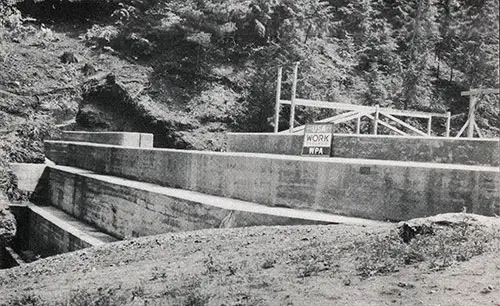
Front view of new Rosendale Dam. Spring floods swept away the old dam in 1936.
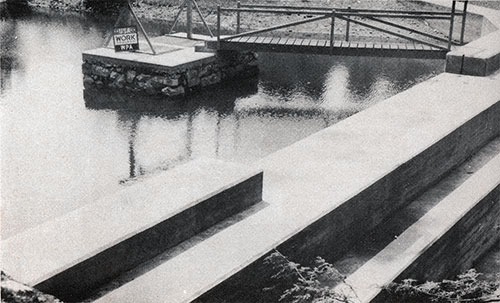
Another view of Rosendale Dam, Ulster County, showing completed wall construction.
The WPA-built dam is twenty feet thick at the base and four feet at top. Impounding 300,000 gallons and assuring ample fire protection and water supply for households, Rosendale Dam is recognized as an outstanding instance of community improvement.
Typical of many village sewage systems constructed by WPA is that at Alden, in Erie County, where a new sewer system and a sewage disposal plant were built. More than seven miles of sewer lines warn laid with Federal lands, providing work for hundreds of men from home relief lists.
In Chautauqua County, the village of Fredonia and farm families in the vicinity suffered many times In the past from water shortage. Sponsored by the locality, two dams, a reservoir, spillway, two new Intakes, a tunnel 740 feet long and a new aerator were constructed by WPA workers. The reservoir has a capacity of 300,- 000,000 gallons of water, fed by the Chautauqua hills watershed.
Well on their way towards completion are a modern sewage system and disposal plant at Indian Lake Village, Hamilton County, to fill a long-felt need.
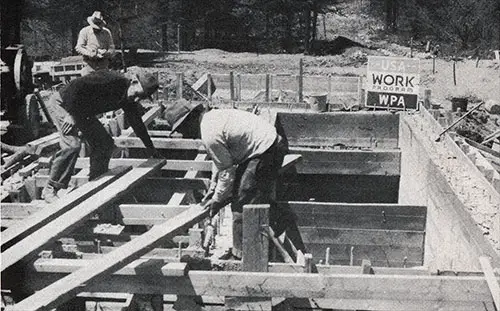
Construction of Sewage Disposal Plant at Indian Lake, Hamilton County. WPA Aids the Farmer: Farm to Market Roads, Compiled and Issued under Direction of Lester W. Herzog, New York State Administor, Works Progress Administration circa 1937. GGA Image ID # 1518875946
Serving as an example of community center improvements in rural villages is the town hall constructed in the Town of Rush, Monroe County. Designed and constructed entirely by relief workers, the completed project provides Rush with a community center, town administration offices, a village library and housing for fire apparatus.
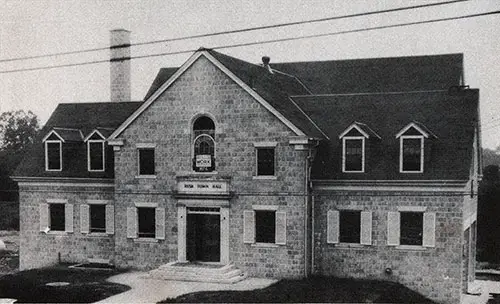
Rush Town Hall Serving as a Community Center and Housing Town Administration Offices, Library and Fire Apparatus. WPA Aids the Farmer: Farm to Market Roads, Compiled and Issued under Direction of Lester W. Herzog, New York State Administor, Works Progress Administration circa 1937. GGA Image ID # 151851fa40
An average of 3,500 students have worked each year in rural high schools, earning monthly amounts up to $6 to continue their education. Similarly, hundreds of the N.Y.A. rural workers have benefited from Student Aid in a working-earning program in colleges and universities within the State.
In short, the WPA has done a great deal for the farmer along many different lines. It has opened to his children new opportunities for recreation and self-betterment.
It has built roads to make possible surer and faster delivery of his produce. It has often meant a much more pleasant environment through the construction of recreation fields, swimming pools, town halls, and new school buildings. And it has placed additional safeguards around the health of his family.
In addition to all this, WPA has taken an appreciable part of the financial load off the farmer's shoulders by taking thousands of unemployed off the home relief, or dole, payrolls and putting them to work in practical and beneficial ways.
The taxpayer — be he farm or city dweller — has to pay sixty per cent of the home relief load, the state contributing forty per cent and for the sixty per cent impost he gets nothing back. Work relief under WPA costs him but a fraction of the home relief bill and for it he gets a substantial return in both economic and social values.
Works Progress Administration, "WPA Aids the Farmer," A brief summary of the activities of the Works Progress Administration in rural areas, Compiled and issued under Direction of Lester W. Herzog (New York State Administrator)

